|
|
|
|
|
Intel's MatrixRAID Examined |
|
Join the community - in the OCAU Forums!
|
Performance Comparison
HOW DOES MATRIXRAID PERFORM?
To find out how the MatrixRAID volumes perform we will compare both arrays with a single disk. Another interesting question is how MatrixRAID compares to regular, non-Matrix RAID. For this purpose we will compare the MatrixRAID arrays with RAID 0 and RAID 1 arrays that have been set up separately on the ICH6-R and not as part of MatrixRAID. Finally, just for fun, we want to see how RAID 0 with four disks is performing on the ICH6-R. Although the ICH6-R is providing 4 SATA channels, it is not possible to set up a RAID 0 array with 4 physical hard disks. If 4 hard disks are connected, only 2 independent MatrixRAID volumes can be created, but not a RAID 0 or RAID 1 volume with 4 hard disks. We found however a way to circumvent this limitation. We installed Windows on a 5th hard disk and then created two RAID 0 arrays with 2 hard disks each. We then combined these 2 RAID 0 arrays (with 4 disks in total) with Dynamic Disk in Windows XP Pro to one combined striped RAID 0 volume. Windows XP cannot be installed on a Dynamic Disk volume. To run RAID 0x4 with Dynamic Disk requires therefore a 5th hard disk on which Windows XP Pro has been installed. Dynamic Disk is not available with Windows XP Home Edition. Such a 5 hard disk scenario is rather unlikely for desktop usage and we tested it only to demonstrate how the IH6-R's four native SATA channels are handling four high performance disks in RAID 0.
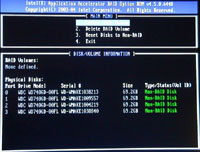 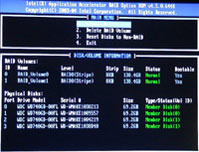
We benchmarked with the following system configuration:- P4 3.46 GHz Extreme Edition
- Crucial Ballistix DDR2 667 memory running at 533 MHz
- Asus P5AD2-E motherboard
- Windows XP Pro, SP2
- 4 SATA Western Digital Raptor WD740GB hard disks
- 1 PATA 160 GB Maxtor Diamond Plus 9 hard disk
- ATI Radeon 800XT PCI-Express video card
The first step of evaluating hard disk performance is usually measuring sequential read, random access and interface burst speeds. For this purpose we used Simpli Software HdTach 3.0. This comes with the ability to compare two storage devices on-screen at the same time and that is exactly what we needed for our comparisons.
Note that in the four graphs below, the MatrixRAID result line is red.
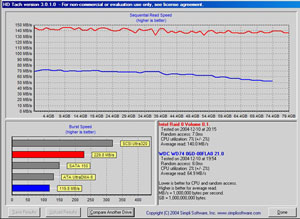 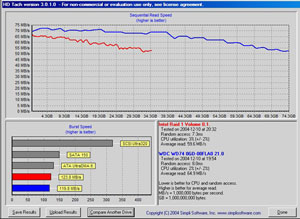
Comparison with single disk: MatrixRAID 0 (left) and MatrixRAID 1 (right)
The HdTach results show that the read speed with the MatrixRAID 0 is more than double than with a single disk. Reading data from a MatrixRAID 1 array however seems to be a little slower than with a single hard disk. These results with HdTach confirm the basic performance concept of a combined 0+1 volume: The 0 array gives speed; the 1 array gives redundancy without being faster or substantially slower than a single disk.
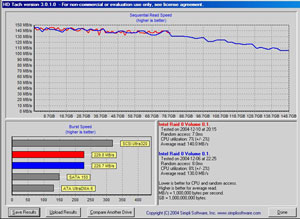 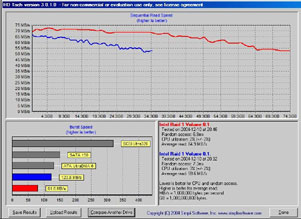
Comparison with standalone array: MatrixRAID 0 (left) and MatrixRAID 1 (right)
How are the RAID 0 and 1 arrays used for the MatrixRAID volumes faring against separately set up RAID 0 and 1 arrays? HdTach shows that a MatrixRAID 0 array and a separate RAID 0 array are performing virtually identically in terms of transfer rate, burst speed, and access time. The MatrixRAID 1 array however is slower than a separate RAID 1 array in both read and burst speeds. The difference however is small and most probably not noticeable in actual use.
High read and write speeds is a basic requirement for disk performance, but it is not a guarantee for high performance when applications are running. These benchmarks are calculated by writing and reading small files in a regular pattern to and from the hard disk. Such a regular pattern is not how applications access hard disks during real world usage. The very high read/write speeds achieved with a RAID 0 array are therefore in no way guaranteeing a similar performance gain when actual applications are running. For testing MatrixRAID performance with actual applications we used the "Hard Disk Test Suite" included in PCMark 2004 Pro 1.2 and the "DiskMark Tests" included in Winbench99. Both of these benchmarks are application based and give a better picture about real world performance than simple transfer rates. The applications used in both benchmarks are scripted in a way that they aggressively read and write to the disk in order to magnify the impact of hard disk performance. Bear in mind that Winbech99 is using outdated applications that are not in use any longer. However, the score still gives a much better picture about real world performance than the read and write speed. The WB99 "Business Disk WinMark" consists of Corel WordPerfect Suite 8, Lotus SmartSuite and Microsoft Office 97 and is only reporting one aggregated score. The WB99 "High-End Disk Mark" is based on AVS/Express 3.4, FrontPage 98, Microstation SE, Photoshop 4.0, Premiere 4.2, Sound Forge 4.0 and Visual C++. It returns individual scores for each application as well as a weighted average.
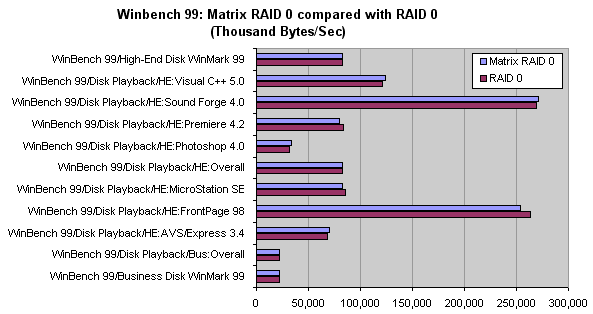
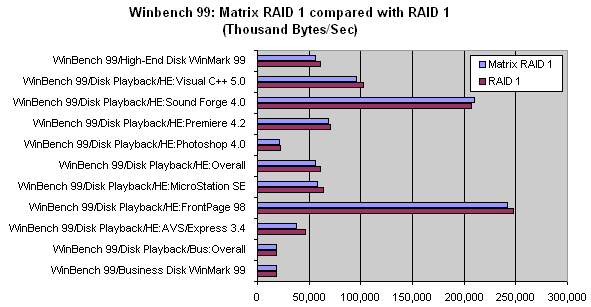
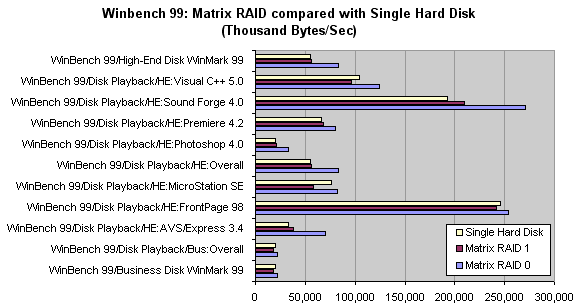
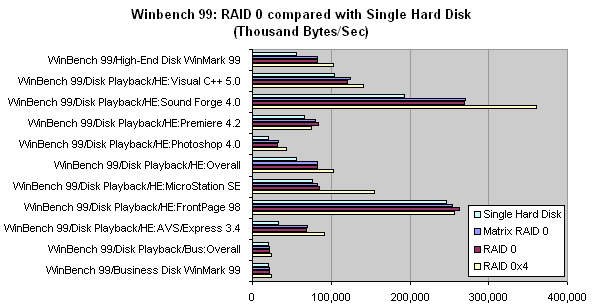
The WB99 tests show MatrixRAID 0 and RAID 0 performance as basically identical. The differences are minuscule and seem to be random. Both are performing between 20% and 30% faster than a single disk. But all RAID results are dwarfed by RAID 0 with 4 hard disks. The scores are sky rocketing. MatrixRAID 1 appears to be around 10% lower than RAID 1. Such a difference is too small to be noticeable for the user. In comparison with a single disk MatrixRAID 1 performs in some test slightly slower and in others slightly faster. But again the differences are too small to be actually noticeable in real world usage. Our conclusion from the WB99 test results is that MatrixRAID 0 can be (we are careful here) faster than a single disk, and that MatrixRAID 1 is basically performing like a single disk. The performance differences between MatrixRAID volumes, and separately-configured RAID 0 and RAID 1 volumes, are negligible.
|
|
Advertisement:
All original content copyright James Rolfe.
All rights reserved. No reproduction allowed without written permission.
Interested in advertising on OCAU? Contact us for info.
|

|


